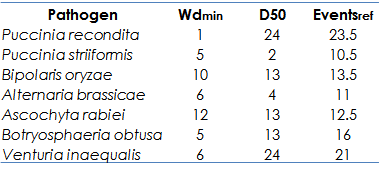The model described in the topic "The generic infection model" was implemented to dynamically compute the daily number of infection events with an hourly time step, according to Bregaglio et al. (2012). The flow diagram of the model is presented in Figure 1.

Flow diagram of the model for a generic infection of foliar fungal plant pathogens
developed by Magarey et al. (2005). Th is hourly air temperature,
the other symbols are explained in the topic "The generic infection model" .
At each hour, if there is leaf wetness (condition A) and air temperature is between Tmin,inf and Tmax,inf (condition B), the model adds a cohort of spores, which could lead to a successful infection; otherwise it loops over the pre-existing not yet completed infection events. For each of them, it evaluates the duration of the dry period, and in case it exceeds D50, the model deletes that specific cohort of spores; otherwise it adds 1 h to the dry period experimented by the cohort. If condition A and B are satisfied, the model computes the average air temperature experimented by that cohort of spores and evaluates the temperature response function. Then, f(t) is scaled to the leaf wetness requirement. The model considers that an event is fulfilled if the duration of Wsum ranges from WDmin and WDmax. Otherwise, if Wsum < WDmin, the infection event remains incomplete and will be evaluated at the next time step; if Wsum > WDmax, the model deletes that cohort of spores. According to this logic, when an infection event is triggered, one item is added to the list of the total number of events in a day.
This model can compute up to 24 events in a day (i.e., one successful infection event at each hour of the day). Given that the plant pathogens markedly differ in the wetness duration requirement, a method was developed to derive a daily infection index, based on the number of successful infection events and of the temperature response function of each event. This method is based on the wetness requirement of a pathogen, and allows to discriminate between pathogens with different moisture requirements. A pathogen-specific reference number of infection events (Eventsref) is computed as:

This method allows to maximize Eventsref in case of pathogens (i) able to complete an infection event in a short number of hours (i.e., low values of WDmin) and (ii) pathogens very sensitive to an interruption of two wet periods (i.e., low values of D50), and vicecersa. In case of pathogens which are sensitive to relative humidity as the driving moisture source for infection, WDmin is substituted with the minimum duration of hours above a pathogen specific relative humidity threshold.
Some examples of Eventsref values related to fungal plant pathogens are reported in the table below, together with their wetness requirements.
Wetness duration requirements of some pathogens and the
reference value of daily infection events (Eventsref)

Daily infection index (Infeff, %) is then derived as:

where i is an infection event, n is the total number of infection events in a day and f(t) is the temperature response function of the i event.
Created with the Personal Edition of HelpNDoc: Full-featured EBook editor